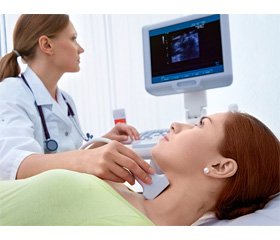Журнал «Боль. Суставы. Позвоночник» 2 (18) 2015
Вернуться к номеру
Hypovitaminosis D in Autoimmune Thyroiditis Patients with Subclinical and Overt Hypothyroidism
Авторы: Pankiv I. - Institute of Gerontology named after D.F. Chebotarev AMS Ukraine, Kyiv, Ukraine
Рубрики: Ревматология, Травматология и ортопедия
Разделы: Медицинские форумы
Версия для печати
Статья опубликована на с. 93-94
Introduction. There is increasing interest in the role of vitamin D deficiency in a number of chronic health problems including autoimmune diseases. A number of factors have been implicated in pathogenesis of most autoimmune disorders, one of the most recent agents found to be associated with autoimmunity is vitamin 25(OH)D. Serum 25(OH)D, the most abundant circulating precursor of active vitamin D, is the most widely accepted indicator of vitamin D status and reflects combined contributions from cutaneous synthesis. Importantly, both vitamin D and thyroid hormone bind to similar receptors called steroid hormone receptors. A different gene in the vitamin D receptor was shown to predispose people to autoimmune thyroid disease including Graves’ disease and Hashimoto’s thyroiditis.
Aim: to investigate the total vitamin 25(OH)D in 70 autoimmune thyroiditis patients with subclinical (n = 21) and overt (n = 49) hypothyroidism.
Material and methods. 70 patients and 20 apparently healthy individuals with matched age and sex were underwent a detailed clinical examination, thyroid function tests (TSH, fT4, fT3, thyroid peroxidase antibodies) and serum total vitamin 25(OH)D. They were living in Kolomyja region and recruiting to outpatient clinic of Central Regional Hospital during the period from September 2013 to July 2014. Written consent was taken from all participants in this study. They were classified into three main groups: Group I. Patients with autoimmune thyroiditis and subclinical hypothyroidism. It included 21 patients (3 male (14.3 %) and 18 female (85.7 %)), their mean ages 46.36 ± 2.84 years. They were diagnosed as patients with subclinical hypothyroidism if TSH level was higher than 4.0 µIU/ml with normal levels of fT3 and fT4. Group II. Patients with autoimmune thyroiditis and overt hypothyroidism. It included 49 patients (13 male (26.5 %) and 36 female (73.5 %)), their mean ages 48.16 ± 3.19 years. They were diagnosed as patients with overt hypothyroidism if TSH level was higher than 4.0 µIU/ml with lower levels of fT3 and fT4 than normal value. Group III. Control group included 20 apparently healthy individuals (3 male (15 %) and 17 female (85 %)), their mean ages are 47.20 ± 2.78 years. They were not complaining from any chronic medical diseases with normal clinical examinations, no history of thyroid diseases or any chronic illness may interfere with our results. They were not on vitamin D supplements.
Results. Levels of serum TSH were significantly increased in subclinical (6.80 ± 1.84 µIU/ml) and hypothyroid (10.24 ± 2.09 µIU/ml) groups as compared to control group (2.16 ± 0.39 µIU/ml) (p < 0.05). The thyroid peroxidase antibodies level was 312.83 ± 7.19 IU/ml in subclinical hypothyroid group and was 529.31 ± ± 9.62 IU/ml in the hypothyroid group. The levels of serum total 25(OH)D were significantly decreased in subclinical (21.9 ± 1.1 nmol/L) and overt hypothyroid groups (18.8 ± 1.2 nmol/L) as compared to control group (27.1 ± 1.2 nmol/L) (p < 0.05). A highly significant negative correlation was found between serum TSH, thyroid peroxidase antibodies and total 25(OH)D levels (p < 0.001). Also highly significant positive correlation was found between the levels of serum total 25(OH)D and serum fT4 (p < 0.001). There was significant positive correlation between TSH and thyroid peroxidase antibodies levels (p < 0.05).
Conclusions. We showed, that there was a highly significant decrease in (25OH)D levels in autoimmune thyroiditis patients both in the subclinical and overt hypothyroid groups as compared to control group. A highly significant negative correlation was found between serum TSH, thyroid peroxidase antibodies and total 25(OH)D levels. Also highly significant positive correlation was found between the levels of serum total 25(OH)D and serum fT4.

